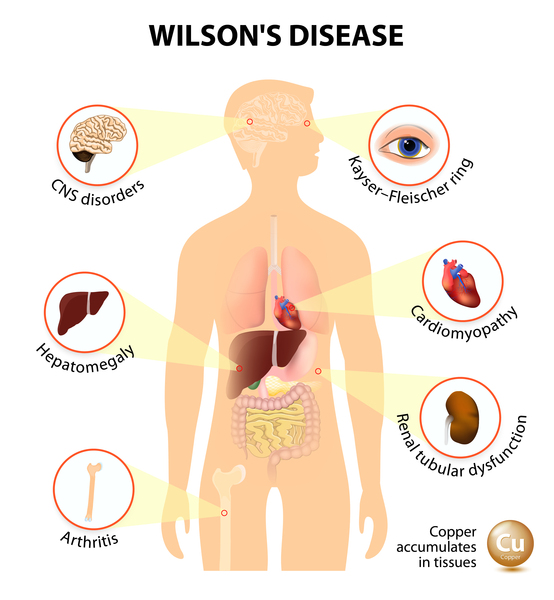Wilson’s disease is a genetic disorder that makes copper build up in the body and causes poisoning; it is also called hepatolenticular degeneration and progressive lenticular degeneration.
Copper is an essential mineral that carries out many bodily functions, including developing healthy bones, skin pigmentation and collagen. It is derived from food naturally, but excess copper in the body is excreted through bile produced in the liver. People who have Wilson’s disease inherit it from their parents, and the condition prevents copper from being excreted appropriately. So it continues to build up in the liver, brain and other organs.
Causes
The gene responsible for removing copper from the body is the ATP7B gene. Wilson’s disease is caused by a defect or mutation of this gene. However, this defective gene must be present in both parents for a child to inherit and develop the disease.
People who inherit only one defective gene won’t have an occurrence of the disease but can still pass the gene to their offspring. This condition is uncommon; it affects about 1 in 30,000 people.
Symptoms of Wilson’s Disease
Although Wilson’s disease is present from birth, the symptoms don’t appear till copper levels accumulate in the eyes, brain, liver and other vital organs. Also, the symptoms vary based on the parts of the body that are affected.
Symptoms include:
- Yellowing of the skin and eyes (jaundice).
- Tiredness.
- Loss of appetite.
- Problems with speech, physical coordination and swallowing.
- Golden brown rings around the iris (kayser-Fleischer rings).
- Depression, personality and mood changes.
- Fluid buildup in the legs or abdomen.
- Uncontrolled movements or muscle stiffness.
- Trouble falling asleep or staying asleep.
If left untreated, Wilson’s disease can lead to several health complications, which can include:
- Psychological problems.
- Liver cirrhosis.
- Kidney problems.
- Liver failure.
- Blood problems.
- Neurologic problems.
Treatment
The treatment for Wilson’s disease is done in 3 stages. First, your doctor will focus on removing excess copper from the body. Chelating therapy is often used; the chelating agents include trientine and d-penicillamine. These drugs remove copper from the organs and release it into the bloodstream so the kidneys can filter it into your urine.
For the second stage, a zinc supplement is prescribed to maintain normal levels of copper; it stops your body from absorbing copper from food. Zinc is also used to prevent Wilson’s disease if the defective gene is discovered on time.
Lastly, after the level of copper in your body has become normal and symptoms have improved, you will need to focus on long-term maintenance methods, including zinc treatments, regular chelation therapy and monitoring copper levels.
You may also be advised to avoid food with too much copper, such as dried fruit, mushrooms, liver, shellfish, nuts, chocolates and multivitamins.
It may take up to 6 months for medications to work on patients who have already developed symptoms, but if medications do not work, a successful liver transplant can cure Wilson’s disease.



